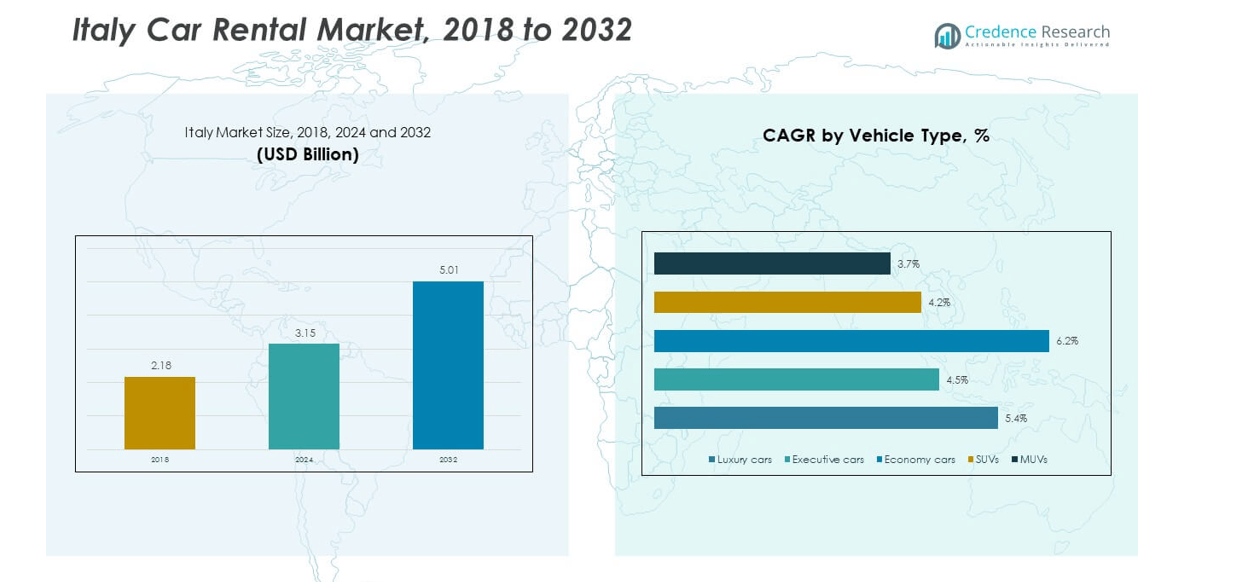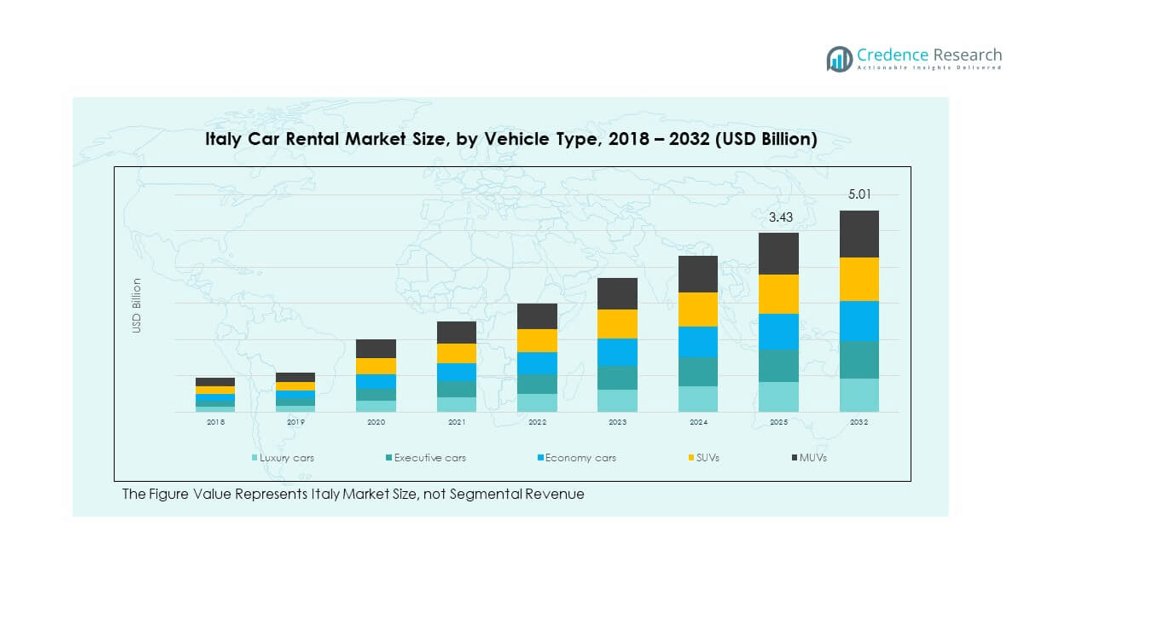CHAPTER NO. 1: GENESIS OF THE MARKET
1.1 Market Prelude – Introduction & Scope
1.2 The Big Picture – Objectives & Vision
1.3 Strategic Edge – Unique Value Proposition
1.4 Stakeholder Compass – Key Beneficiaries
CHAPTER NO. 2: EXECUTIVE LENS
2.1 Pulse of the Industry – Market Snapshot
2.2 Growth Arc – Revenue Projections (USD Billion)
2.3. Premium Insights – Based on Primary Interviews
CHAPTER NO. 3: CAR RENTAL MARKET FORCES & INDUSTRY PULSE
3.1 Foundations of Change – Market Overview
3.2 Catalysts of Expansion – Key Market Drivers
3.2.1 Momentum Boosters – Growth Triggers
3.2.2 Innovation Fuel – Disruptive Technologies
3.3 Headwinds & Crosswinds – Market Restraints
3.3.1 Regulatory Tides – Compliance Challenges
3.3.2 Economic Frictions – Inflationary Pressures
3.4 Untapped Horizons – Growth Potential & Opportunities
3.5 Strategic Navigation – Industry Frameworks
3.5.1 Market Equilibrium – Porter’s Five Forces
3.5.2 Ecosystem Dynamics – Value Chain Analysis
3.5.3 Macro Forces – PESTEL Breakdown
3.6 Price Trend Analysis
3.6.1 Country-wise Price Trend
3.6.2 Price Trend by Product
CHAPTER NO. 4: KEY INVESTMENT EPICENTER
4.1 Country-wise Goldmines – High-Growth Geographies
4.2 Product Frontiers – Lucrative Product Categories
4.3 Application Sweet Spots – Emerging Demand Segments
CHAPTER NO. 5: REVENUE TRAJECTORY & WEALTH MAPPING
5.1 Momentum Metrics – Forecast & Growth Curves
5.2 Country-wise Revenue Footprint – Market Share Insights
5.3 Segmental Wealth Flow – Vehicle Type & Rental Model Revenue
CHAPTER NO. 6: TRADE & COMMERCE ANALYSIS
6.1. Import Analysis by Country
6.1.1. Italy Car Rental Market Import Volume By Country
6.2. Export Analysis by Country
6.2.1. Italy Car Rental Market Export Volume By Country
CHAPTER NO. 7: COMPETITION ANALYSIS
7.1. Company Market Share Analysis
7.1.1. Italy Car Rental Market: Company Market Share
7.1. Italy Car Rental Market Company Volume Market Share
7.2. Italy Car Rental Market Company Revenue Market Share
7.3. Strategic Developments
7.3.1. Acquisitions & Mergers
7.3.2. New Product Launch
7.3.3. Country-wise Expansion
7.4. Competitive Dashboard
7.5. Company Assessment Metrics, 2024
CHAPTER NO. 8: CAR RENTAL MARKET – BY VEHICLE TYPE SEGMENT ANALYSIS
8.1. Car Rental Market Overview by Vehicle Type Segment
8.1.1. Car Rental Market Volume Share By Vehicle Type
8.1.2. Car Rental Market Revenue Share By Vehicle Type
8.2. Luxury cars
8.3. Executive cars
8.4. Economy cars
8.5. SUVs
8.6. MUVs
CHAPTER NO. 9: CAR RENTAL MARKET – BY RENTAL DURATION SEGMENT ANALYSIS
9.1. Car Rental Market Overview by Rental Duration Segment
9.1.1. Car Rental Market Volume Share By Rental Duration
9.1.2. Car Rental Market Revenue Share By Rental Duration
9.2. Hourly Rentals
9.3. Daily Rentals
9.4. Weekly Rentals
9.5. Monthly Rentals
9.6. Others
CHAPTER NO. 10: CAR RENTAL MARKET – BY RENTAL MODEL SEGMENT ANALYSIS
10.1. Car Rental Market Overview by Rental Model Segment
10.1.1. Car Rental Market Volume Share By Rental Model
10.1.2. Car Rental Market Revenue Share By Rental Model
10.2. Airport Rentals
10.3. Local Rentals
10.4. One-way Rentals
10.5. Round-trip Rentals
CHAPTER NO. 11: CAR RENTAL MARKET – BY CUSTOMER SEGMENT ANALYSIS
11.1. Car Rental Market Overview by Customer Segment
11.1.1. Car Rental Market Volume Share By Customer Segment
11.1.2. Car Rental Market Revenue Share By Customer Segment
11.2. Leisure Rentals
11.3. Business Rentals
11.4. Government and Institutional Rentals
11.5. Insurance Replacement Rentals
11.6. Special Events and Occasions Rentals
11.7. Others
CHAPTER NO. 12: CAR RENTAL MARKET – COUNTRY-WISE ANALYSIS
12.1. Car Rental Market Overview by Country Segment
12.1.1. Italy Car Rental Market Volume Share By Country
12.1.2. Italy Car Rental Market Revenue Share By Country
12.1.3. Country
12.1.4. Italy Car Rental Market Volume By Country
12.1.5. Italy Car Rental Market Revenue By Country
12.1.6. Vehicle Type
12.1.7. Italy Car Rental Market Volume By Vehicle Type
12.1.8. Italy Car Rental Market Revenue By Vehicle Type
12.1.9. Rental Duration
12.1.10. Italy Car Rental Market Volume By Rental Duration
12.1.11. Italy Car Rental Market Revenue By Rental Duration
12.1.12. Rental Model
12.1.13. Italy Car Rental Market Volume By Rental Model
12.1.14. Italy Car Rental Market Revenue By Rental Model
12.1.12. Customer Segment
12.1.13. Italy Car Rental Market Volume By Customer Segment
12.1.14. Italy Car Rental Market Revenue By Customer Segment
CHAPTER NO. 13: COMPANY PROFILES
13.1. Europcar Italy
13.1.1. Company Overview
13.1.2. Product Portfolio
13.1.3. Financial Overview
13.1.4. Recent Developments
13.1.5. Growth Strategy
13.1.6. SWOT Analysis
13.2. Maggiore Rent
13.3. Sicily by Car
13.4. Hertz Italy
13.5. Sixt Italy
13.6. Avis Italy
13.7. Locauto Rent
13.8. Leasys
13.9. AutoEurope
13.10. Rent a Car Italy










